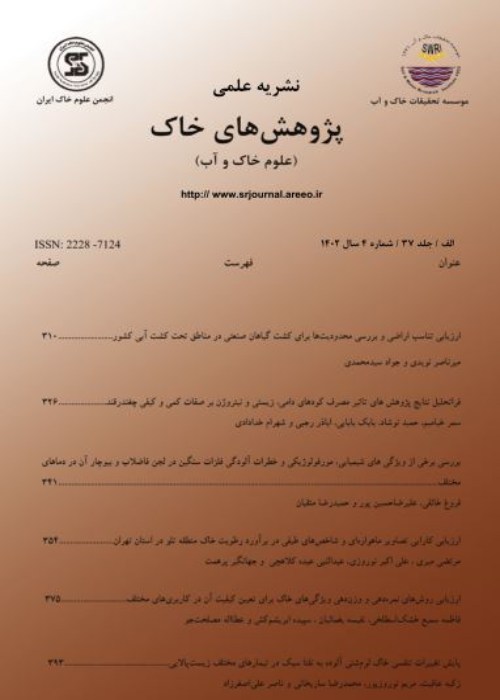Redistribution of Exchangeable Cations in a Saline-Sodic Soil Due to the Application of Different Amendments
Author(s):
Abstract:
Soil salinity and sodicity are important aspects of land degradation، especially in arid and semi-arid regions. This study focused on the effect of different organic and inorganic amendments on saline-sodic soil amelioration with emphasis on the redistribution of exchangeable cations. The experiment was performed as factorial based on complete randomized design using 6 soil treatments including: control، cattle manure، pistachio residue، gypsum، cattle manure+ gypsum، and pistachio residue+ gypsum. Besides، there were two irrigation water treatments: with and without sulfuric acid. All treatments were applied in 3 replicates and the study was conducted in laboratory conditions using soil column. Four intermittent irrigations events with one month intervals and one pore volume per event were applied. The results showed that application of the soil amendments had significant effect on the concentration of exchangeable cations as well as Exchangeable Sodium Percentage (ESP)، while addition of sulfuric acid showed no significant influence on bivalent cations. At the end of amelioration process، the lowest amounts of monovalent cations and the ESP were found in the surface layer increasing with soil depth، whereas no significant changes were observed for the bivalent cations. The exchangeable sodium increased in all the applied treatments، except pistachio residue (with and without sulfuric acid) and pistachio residue+ gypsum، which resulted in some decreases. All treatments، especially pistachio residue، increased exchangeable potassium. Cattle manure was the only amendment that decreased exchangeable calcium compared to the control. The application of gypsum in comparison to the control showed the highest effect on increasing exchangeable calcium and magnesium، however، in the presence of sulfuric acid، it decreased in some treatments. The results indicated that، in the presence of sulfuric acid، pistachio residue and gypsum treatments had the highest influence on decreasing ESP، but in the absence of sulfuric acid، pistachio residue alone or in combination with gypsum was the most effective treatment in decreasing ESP. Also، since the soil was calcareous، sulfuric acid exhibited more efficiency than gypsum in decreasing ESP. Finally، the findings of this research highlight the importance of pistachio residue in ameliorating calcareous saline-sodic soils.
Keywords:
Language:
Persian
Published:
Iranian Journal of Soil Research, Volume:27 Issue: 2, 2013
Pages:
179 to 193
magiran.com/p1164871
دانلود و مطالعه متن این مقاله با یکی از روشهای زیر امکان پذیر است:
اشتراک شخصی
با عضویت و پرداخت آنلاین حق اشتراک یکساله به مبلغ 1,390,000ريال میتوانید 70 عنوان مطلب دانلود کنید!
اشتراک سازمانی
به کتابخانه دانشگاه یا محل کار خود پیشنهاد کنید تا اشتراک سازمانی این پایگاه را برای دسترسی نامحدود همه کاربران به متن مطالب تهیه نمایند!
توجه!
- حق عضویت دریافتی صرف حمایت از نشریات عضو و نگهداری، تکمیل و توسعه مگیران میشود.
- پرداخت حق اشتراک و دانلود مقالات اجازه بازنشر آن در سایر رسانههای چاپی و دیجیتال را به کاربر نمیدهد.
In order to view content subscription is required
Personal subscription
Subscribe magiran.com for 70 € euros via PayPal and download 70 articles during a year.
Organization subscription
Please contact us to subscribe your university or library for unlimited access!


